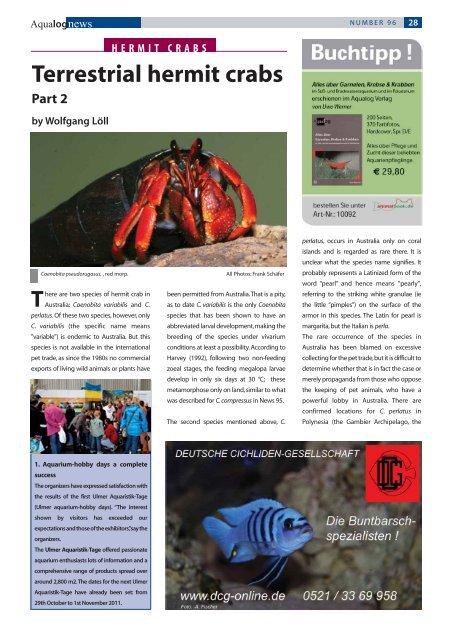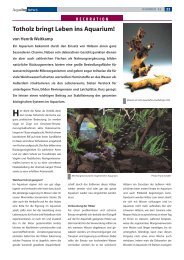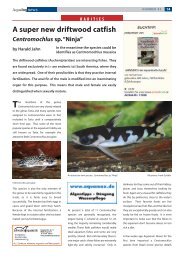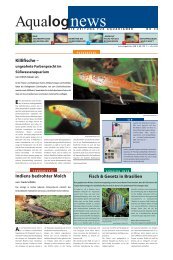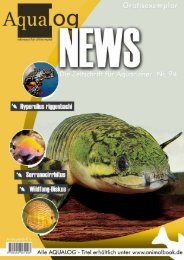Moenkhausia cosmops - Aqualog
Moenkhausia cosmops - Aqualog
Moenkhausia cosmops - Aqualog
Create successful ePaper yourself
Turn your PDF publications into a flip-book with our unique Google optimized e-Paper software.
<strong>Aqualog</strong>news NUMBER 96 28<br />
HERMIT CRABS<br />
Terrestrial hermit crabs<br />
Part 2<br />
by Wolfgang Löll<br />
T<br />
Coenobita pseudorugosus, ,red morp. All Photos: Frank Schäfer<br />
here are two species of hermit crab in<br />
Australia: Coenobita variabilis and C.<br />
perlatus.Of these two species, however, only<br />
C. variabilis (the specific name means<br />
"variable") is endemic to Australia. But this<br />
species is not available in the international<br />
pet trade, as since the 1980s no commercial<br />
exports of living wild animals or plants have<br />
1. Aquarium-hobby days a complete<br />
success<br />
The organizers have expressed satisfaction with<br />
the results of the first Ulmer Aquaristik-Tage<br />
(Ulmer aquarium-hobby days). “The interest<br />
shown by visitors has exceeded our<br />
expectations and those of the exhibitors”,say the<br />
organizers.<br />
The Ulmer Aquaristik-Tage offered passionate<br />
aquarium enthusiasts lots of information and a<br />
comprehensive range of products spread over<br />
around 2,800 m2. The dates for the next Ulmer<br />
Aquaristik-Tage have already been set: from<br />
29th October to 1st November 2011.<br />
been permitted from Australia.That is a pity,<br />
as to date C. variabilis is the only Coenobita<br />
species that has been shown to have an<br />
abbreviated larval development,making the<br />
breeding of the species under vivarium<br />
conditions at least a possibility. According to<br />
Harvey (1992), following two non-feeding<br />
zoeal stages, the feeding megalopa larvae<br />
develop in only six days at 30 °C; these<br />
metamorphose only on land, similar to what<br />
was described for C. compressus in News 95.<br />
The second species mentioned above, C.<br />
perlatus, occurs in Australia only on coral<br />
islands and is regarded as rare there. It is<br />
unclear what the species name signifies. It<br />
probably represents a Latinized form of the<br />
word “pearl” and hence means "pearly",<br />
referring to the striking white granulae (ie<br />
the little “pimples”) on the surface of the<br />
armor in this species. The Latin for pearl is<br />
margarita, but the Italian is perla.<br />
The rare occurrence of the species in<br />
Australia has been blamed on excessive<br />
collecting for the pet trade,but it is difficult to<br />
determine whether that is in fact the case or<br />
merely propaganda from those who oppose<br />
the keeping of pet animals, who have a<br />
powerful lobby in Australia. There are<br />
confirmed locations for C. perlatus in<br />
Polynesia (the Gambier Archipelago, the


